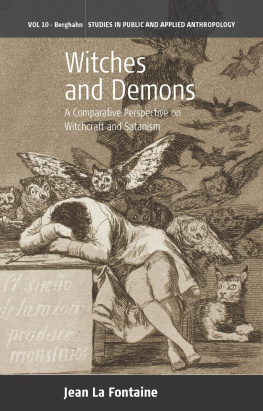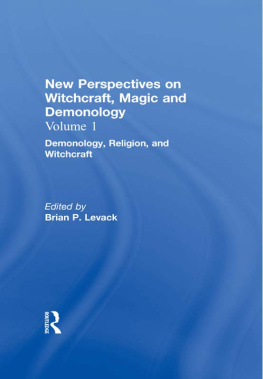Witches and Demons
Studies in Public and Applied Anthropology
General Editors: Sarah Pink, RMIT University, Melbourne, Australia, and Simone Abram, Durham University and Leeds Beckett University
The value of anthropology to public policy, business and third sector initiatives is increasingly recognized, not least due to significant innovations in the discipline. The books published in this series offer important insight into these developments by examining the expanding role of anthropologists practicing their discipline outside academia as well as exploring the ethnographic, methodological and theoretical contribution of anthropology, within and outside academia, to issues of public concern.
Volume 1
Anthropology and Consultancy:
Issues and Debates
Edited by Pamela Stewart and Andrew Strathern
Volume 2
Applications of Anthropology:
Professional Anthropology in the Twenty-First Century
Edited by Sarah Pink
Volume 3
Fire in the Dark:
Telling Gypsiness in North East England
Sarah Buckler
Volume 4
Visual Interventions:
Applied Visual Anthropology
Edited by Sarah Pink
Volume 5
Ethnography and the Corporate Encounter:
Reflections on Research in and of Corporations
Edited by Melissa Cefkin
Volume 6
Adventures in Aidland:
The Anthropology of Professionals in International Development
Edited by David Mosse
Volume 7
Up, Down, and Sideways:
Anthropologists Trace the Pathways of Power
Edited by Rachael Stryker and Roberto J. Gonzlez
Volume 8
Public Anthropology in a Borderless World
Edited by Sam Beck and Carl A. Maida
Volume 9
Media, Anthropology and Public Engagement
Edited by Sarah Pink and Simone Abram
Volume 10
Witches and Demons:
A Comparative Perspective on Witchcraft and Satanism
Jean La Fontaine
Witches and Demons
A Comparative Perspective on Witchcraft and Satanism
Jean La Fontaine
Published in 2016 by
Berghahn Books
www.berghahnbooks.com
2016 Jean La Fontaine
All rights reserved. Except for the quotation of short passages for the purposes of criticism and review, no part of this book may be reproduced in any form or by any means, electronic or mechanical, including photocopying, recording, or any information storage and retrieval system now known or to be invented, without written permission of the publisher.
Library of Congress Cataloging-in-Publication Data
Names: La Fontaine, J. S. (Jean Sybil), 1931 author.
Title: Witches and demons: a comparative perspective on witchcraft and Satanism / Jean La Fontaine.
Description: New York: Berghahn Books, [2016] | Includes bibliographical references and index.
Identifiers: LCCN 2015045572| ISBN 9781785330858 (hardback: alk. paper) | ISBN 9781785331527 (pbk.: alk. paper) | ISBN 9781785330865 (ebook)
Subjects: LCSH: Witchcraft. | Good and evil. | Demonology.
Classification: LCC BF1566 .L3 2016 | DDC 133.409--dc23 LC record available at http://lccn.loc.gov/2015045572
British Library Cataloguing in Publication Data
A catalogue record for this book is available from the British Library
ISBN 978-1-78533-085-8 hardback
ISBN 978-1-78533-152-7 paperback
ISBN 978-1-78533-086-5 ebook
ACKNOWLEDGEMENTS

These articles have emerged from papers and lectures delivered to many university departments, primarily in anthropology and the sociology of religion and edited, where necessary, to bring them up to date. I am happy to thank the following institutions for their invitations and for the stimulating discussions of my material that ensued: the universities of New Hampshire, USA (The Saul Sidore Memorial Lecture), Amsterdam, St Andrews, Sussex, University College London and the Institute for Anthropological Research in Africa of the University of Leuven in Brussels. One chapter on children and evil was the result of time spent as Visiting Professor in Tema Barn, the institute for research on children at Linkoping University, Sweden; although not based on any particular paper it owes a good deal to papers and seminars I gave there and on visits to the anthropology department of the University of Copenhagen. My warm thanks to both institutions for their hospitality. Two other chapters are revised versions of published articles and I am grateful to the editors of the journal Etnofoor, published by the University of Amsterdam, and to INFORM and their publishers, Ashgate, for permission to reprint these, albeit in somewhat revised versions. I must also thank the Metropolitan Police for permission to read cases in their archives; I hope my report on them, on which an additional chapter was based, was useful.
I benefitted greatly from the reviews of the two readers of my manuscript; I thank them both. I enjoyed several useful discussions with Dr Joost Fontein of the court case we were both associated with. Finally, I particularly wish to thank Amanda Sackur who rescued me from the becalmed doldrums of revision, enabling me to rewrite the Introduction. Many thanks also to my grandson, Kwami Odoom, for constructing the index.
Berghahns editorial staff have been a pleasure to work with: so quick to respond and so patient with my delays! Thank you.
My family has always been a source of comfort and support; I dedicate this book to them all with my love.
Jean La Fontaine
INTRODUCTION
Understanding the Other

Devil worship, black magic and witchcraft are the subjects of discussion in this book. The approach that informs them shows its anthropological nature in three basic elements. First, in various ways the chapters all display the comparative method, the long-accepted means by which anthropology has drawn conclusions about particular societies, tested generalisations and theories against this ethnography and thus contributed to the body of theories that explain society in a general sense. Secondly, they consider the anthropologists perpetual problem, which is that they are members of a particular society themselves and cannot entirely divest themselves of its ways of thinking and feeling in order to achieve the neutral, unbiased approach to their material that is the professions ideal. Despite themselves, they may distort their understanding of their subject matter by an ethnocentric attitude to the other societies they study. Finally, the chapters share a subject matter that exemplifies culturally shaped but changeable ideas and behaviour, and the way in which both of these react to the social, political and economic background that forms their context.














